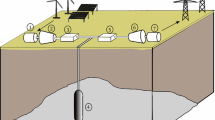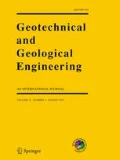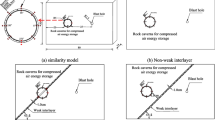Abstract
The compressed air energy storage (CAES) method is a viable method of storing surplus energy underground when there is a mismatch between energy generation and demand. Wellbores embedded in rock are an integral part of energy storage structures, and are used for injecting and extracting the compressed air. During injection and production cycles, the storage reservoir and wellbore are subjected to cyclic change in external pressure and temperature, which may cause failure of the wellbore. In this paper, cyclic thermo-mechanical analysis of a horizontal wellbore in an underground CAES cavern is performed using finite element analysis. The rock behavior is simulated using the Mohr-Coulomb constitutive law. The reduction in the yield strength of rock with increase in the number of loading cycles is taken into account in the analysis. Parametric sensitivity studies are carried out to study the effects of dilation and friction angles of rock, the ratio of in situ horizontal and vertical stresses, loading frequency, and the magnitude of the temperature cycles in the cavern on the wellbore performance for different types of rock. The thermo-mechanical cyclic behavior leads to plastic strains that are greater than those obtained by performing mechanical analysis only. Significantly large deformation is generated in rock for large dilation angle and high loading frequencies.












Similar content being viewed by others

References
Abaqus/Standard User’s Manual, Version 6.11. Dassault Systèmes Simulia Corporation, Providence, Rhode Island, USA
Allen RD, Doherty TJ, Fossum AF (1982). Geotechnical issues and guidelines for storage of compressed air in excavated hard rock caverns. Prepared for the U.S Department of Energy under Contract DE-AC06-76RLO 1830
Allen RD, Doherty TJ, Erikson RL, Wiles LE (1983) Factors affecting storage of compressed air in porous-rock reservoirs, PNL-4707, Pacific Northwest Laboratory, Richland, WA. http://www.osti.gov/bridge/servlets/purl/6270908-rnFs1F/. 15 July 2010
Allen RD, Doherty TJ, Kannberg LD (1985) Summary of selected compressed air energy storage studies, PNL-5091, Pacific Northwest Laboratory, Richland, WA. http://www.osti.gov/energycitations/servlets/purl/5872515-nnHCP0/. 15 July 2010
Austin NJ, Kennedy LA, Logan JM, Rodway R (2005) Textural controls on the brittle deformation of dolomite: the transition from brittle faulting to cataclastic flow. In: Gapais D, Brun JP, Cobbold PR (eds) Deformation mechanisms, rheology and tectonics: from minerals to the lithosphere. Geological Society Special Publication 243, UK
Brandshaug T (1980) Thermomechanical assessment of compensated CAES Caverns in Hard Rock. In: Summers DA (ed) Proceedings, 21st U.S. Symposium on rock mechanics, University of Missouri–Rolla, Rolla, MO. University of Missouri–Rolla, Rolla, MO, pp 163–174
Bullough C, Gatzen C, Jakiel C, Koller M, Nowi A, Zunft S (2004) Advanced adiabatic compressed air energy storage for the integration of wind energy. In: European wind energy conference, EWEC 2004, 22–25 November 2004, London, UK
Fossum AF, Brandshaug T (1980) Numerical and laboratory studies of CAES reservoirs in the Sykesville Gneiss. In: Mechanical, magnetic, and underground energy storage 1981 annual contractors’ review, PUB_81-07.pdf
Fuenkajorn K, Phueakphum D (2010) Effects of cyclic loading on mechanical properties of Maha Sarakham salt. Eng Geol 112:43–52
Giramonti AJ, Lessard RD, Blecher WA, Smith EB (1978) Conceptual design of compressed air energy storage electric power systems. Appl Energy 4(4):231–249
Haimson BC (1978) Effect of cyclic loading on rock, dynamic testing. In: ASTM STP 654, American society for testing material, pp 228–245
Jaeger JC, Cook NGW, Zimmerman R (2009) Fundamentals of rock mechanics. Blackwell Publishing, Victoria
Katz DL, Lady ER (1976) Compressed air storage for electric power generation. Ulrich’s Books, Ann Arbor, MI
Kim H, Rutqvist J, Ryu DW, Choi BH, Sunwoo C, Song WK (2012) Exploring the concept of compressed air energy storage (CAES) in lined rock caverns at shallow depth: a modeling study of air tightness and energy balance. Appl Energy 92:653–667
Mongelli F, Loddo M, Tramacere A (1982) Thermal conductivity, diffusivity and specific heat variation of some travel field (Tuscany) rocks versus temperature. Terrestial Heat Flow Tectonophys 83:33–43
Najjar YSH, Jubeh NM (2006) Comparison of performance of compressed air energy storage plant with compressed air storage with humidification. Proc Inst Mech Eng Part A J Power Energy 220(6):581–588
Pasten C, Santamarina JC (2011) Energy geo-storage—analysis and geomechanical implications. KSCE J Civil Eng 15(4):655–667
Raju M, Khaitan SK (2012) Modeling and simulation of compressed air storage in caverns: a case study of the Huntorf plant. Appl Energy 89:474–481
Rutqvist J, Kim HM, Ryu DW, Synn JH, Song WK (2012) Modeling of coupled thermodynamic and geomechanical performance of underground compressed air energy storage in lined rock caverns. Int J Rock Mech Min Sci 52:71–81
Succar S, Williams RH (2008) Compressed air energy storage: theory, resources, and applications for wind power. Princeton Environmental Institute, Princeton University, Princeton, NJ
Thirumalai K, Demou SG (1974) Thermal expansion behaviour of intact and thermally fractured mine rocks. Int J Rock Mech Min Sci Geomech 17:60–71
Thoms RL, Martinez JD (1978) Long-term stability criteria for compressed air energy storage caverns in salt domes. CAES technology symposium, Asilomar, CA, pp 369–383
Timoshenko SP, Goodier JN (2011) Theory of elasticity, 3rd edn. Tata McGraw-Hill, New York, p 567
Waltham T (2009) Foundations of engineering geology. Taylor & Francis, London
Watson K, Jones C (2010) Cyclic loading of a rock mass for underground gas storage applications. Weatherford international presented at the (Abaqus FEA Users) 2010 Simulia customer conference
Wells PRA (1980) Thermal models for the magmatic accretion and subsequent metamorphism of continental crust. Earth Planet Sci Lett 46:253–265
Xiao JQ, Ding DX, Jiang FL, Xu G (2010) Fatigue damage variable and evolution of rock subjected to cyclic loading. Int J Rock Mech Min Sci 47:461–468
Zaloudek FR, Reilly RW (1982) An assessment of second generation compressed air energy storage concepts, PNL-3978, Pacific Northwest Laboratory, Richland, WA. http://www.osti.gov/bridge/product.biblio.jsp?osti_id=5273339. 22 Jan 2011
Author information
Authors and Affiliations
Corresponding author
Rights and permissions
About this article
Cite this article
Mohanto, S., Singh, K., Chakraborty, T. et al. Cyclic Thermo-Mechanical Analysis of Wellbore in Underground Compressed Air Energy Storage Cavern. Geotech Geol Eng 32, 601–616 (2014). https://doi.org/10.1007/s10706-014-9736-9
Received:
Accepted:
Published:
Issue Date:
DOI: https://doi.org/10.1007/s10706-014-9736-9



